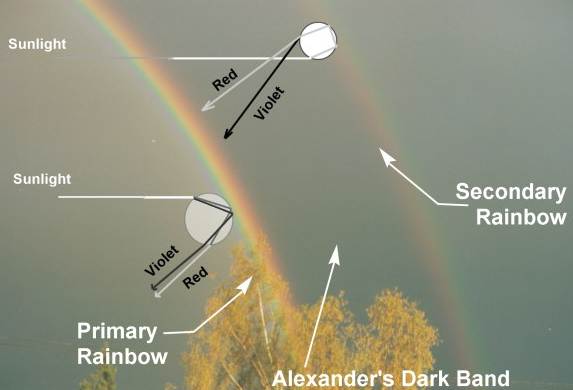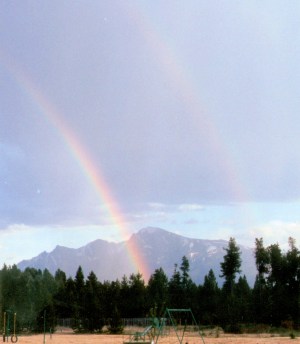 |
 |
| Home | Welcome | What's New | Site Map | Glossary | Weather Doctor Amazon Store | Book Store | Accolades | Email Us |
 | |||||||||
RainbowsRainbows have been part of human mythology and culture for millennia: from the story of Noah to Viking legends to Native American tribal beliefs to Buddhist traditions. Rainbows have fascinated scientists through the ages as well, including such well known names as Aristotle, Newton and Pascal. Forming a rainbow requires two items. The first is rain or another source of liquid water drops; the second is a strong light source. While most rainbows we see are caused by sunlight, the moon when it is bright is just as capable in producing bows, called moonbows. When solar light shines on falling raindrops, it enters the drop and is bent from its straight-line path through a process known as refraction. If the light beam contains multi-coloured wavelengths — unadulterated sunlight contains all the colours of the visible spectrum — they are split by the refraction into bands of pure-colour wavelengths, just as a prism splits "white" light into the spectrum. A portion of these rays, now travelling along slightly different paths than the original beam, is then reflected off the back surface of the raindrop toward the sun. On leaving the drop, a second refraction spreads the colours into a parallel front of beams back toward the sun. Violet light emerges at an angle of 40 degrees relative to the incoming sunlight. Red light exits at an angle of 42 degrees. Other colours emerge from the raindrop at angles between 40 and 42 degrees.  Although we usually see a rainbow as a continuous mix of colours, only one colour actually reaches our eyes from each drop. We see red light from higher-altitude drops producing the outer ring of the bow while their other colour rays are directed outside our view. Violet light from lower-altitude drops produces the inner visible ring, while its longer wavelength rays are directed below our line of sight. It therefore takes millions of falling raindrops to produce the full colour spectrum characteristic of a rainbow arch. The size of raindrops influences the rainbow we see. The brightest rainbows appear when drop diameters are between 300 and 1000 micrometres. If drop diameters are large — 1000 micrometres or more — red, yellow, and orange colours are bright but blue is weak. When drops are smaller than 300 micrometres, the red colour bands weaken in favour of the blues. Very small water droplets — those less than 30 micrometres in breadth — produce rainbows that are faint and appear almost white. Fog and clouds contain such small droplets, and thus the bows arising from them are known as fogbows or cloudbows rather than rainbows. When sunlight from very near the horizon produces a rainbow, it may not contain the full spectrum of colours when it strikes the raindrops. Often, such light has lost its bluer wavelengths, giving the sun a reddish appearance. If light rays entering a raindrop are primarily of one colour, the resulting rainbow will reflect that colour. Red incident light beams produce reddish rainbows. Similarly, if the sunlight is orange or golden, so too will be any resulting rainbow. I witnessed a very stunning orange-gold rainbow one December evening that was spectacular to behold, perhaps the single most beautiful skyscape I have ever beheld. The afore-mentioned refraction-reflection-refraction process forms a primary rainbow, so-called because it is the product of a single reflection of light within the raindrops. Not all the returning light escapes the drop, however; some rays are internally reflected within the raindrop a second time before leaving the drop at a different angle (around 51 degrees from the original solar beam) than the single-reflection rays. The resulting rainbow lies outside the primary rainbow arch and is called the secondary rainbow since it forms from that second reflection. The secondary bow is weaker in brightness by about 43 percent than the primary bow, is twice as wide, and has its colour sequence in reverse order. The combination of primary and secondary rainbows is called a "double rainbow." The secondary rainbow lies outside (above) the main primary rainbow. In the primary, violet/blue is on the inner edge with red on the outer. In the secondary bow, the red is on the inner edge and violet/blue on the outer. Between the two bows we see a much darker region known as Alexander's dark band. Most of the returning light from this region has been bent out of our view, thus leaving this section of sky depleted of light rays. In contrast, the rainbow centre appears much brighter than the rest of the sky because there the sunlight reflects directly back from the drop surfaces to our eyes. Every rainbow forms a circle. How much of the circle we see depends on several factors including the width of the rain band and the position of the sun relative to our eyes. The centre of the circle can always be located by imagining a line from the solar disk through our eye position to the sky before us, the antisolar point. As the solar position rises in the sky, the antisolar point lowers until the rainbow arch sinks fully below the horizon. That is why midday rainbows are uncommon to ground observers. However, a rainbow can be seen around midday from aircraft or mountain heights formed on raindrops at lower altitudes. 
Finally, if you and I are standing side by side, and we see a rainbow, we are actually seeing two distinct rainbows, one for you and one for me, each produced by a different ensemble of raindrops. In some instances, the drops that produce my rainbow's red band might be producing another colour in yours or vice versa — it all depends on positioning. Learn More From These Relevant Books
|
|||||||||
 |
To Purchase Notecard, |
Now Available! Order Today! | |
 |
 |
NEW! Now Available in the US! |
The BC Weather Book: |


